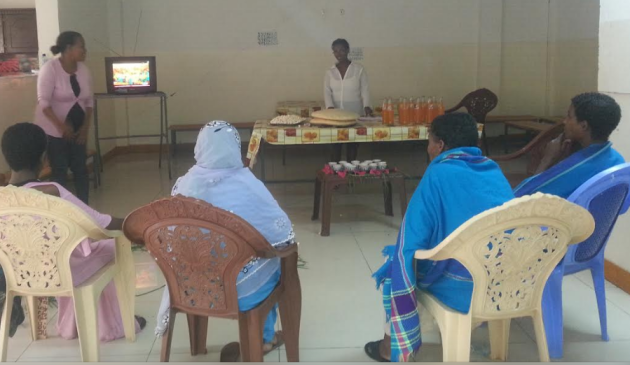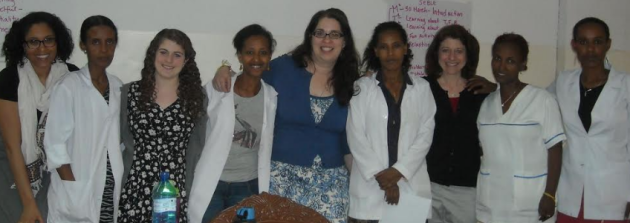
by Eleanor J. Bader
Improving the Lives of Ethiopian Women with Fistula: An Interview with Dr. Gladstone

One of the nurses and the fistula patients in her group, taken at the final group meeting, which is a celebration. Photo courtesy of Dr. Gladstone.
When Dr. Tracy R.G. Gladstone visited Ethiopia’s Gondar Fistula Center in 2015, her goal was to train medical providers to address depression and anxiety in women with obstetric fistula: a hole in the tissues that separate a woman’s vagina, bladder and rectum. Fistula develop during obstructed childbirth when a timely caesarian section is not performed.
“Over the past several years I’ve seen growing recognition of obstetric fistula as a medical issue—non-Governmental Organizations (NGOs) have begun bringing mobile health units into rural areas to provide free repair surgery to women who need it—but not as much attention has been paid to pre- or post- surgical psychological health,” Gladstone, Associate Director and Senior Research scientist at the Wellesley Centers for Women, told Lilith.
Nonetheless, as the connection between physical and emotional health is better understood, Ethiopian medical workers have become increasingly receptive to learning concrete strategies to help women deal with their post-traumatic stress and other psychological problems the condition triggers.
That said, obstetric fistula remains a serious problem throughout much of sub-Saharan Africa and Asia, though it is almost never seen in North America. It is estimated that 39,000 Ethiopian women suffer from fistula. According to The Fistula Foundation, the country has just one physician per 10,000 people. What’s more, 41 percent of Ethiopian women are illiterate and female life expectancy is 67.4 years.
Gladstone became interested in the psychological issues surrounding fistula in 2010, after her pre-teen daughter, Sarah, read Sheryl WuDunn and Nichola Kristof’s book, Half the Sky. Sarah, Tracy Gladstone reports, was so incensed by what she’d read that she decided to raise money for fistula repair as a Bat Mitzvah project. Since then, Sarah has raised more than $10,000 for the effort.
In tandem with Sarah, Tracy Gladstone has created the COFFEE Project: Cognitive Behavioral Therapy with Obstetric Fistula for Education and Empowerment. She recently spoke to Eleanor J. Bader about her work.
Eleanor J. Bader: What are the issues that women with obstetric fistula face before and after having repair surgery?
Tracy R.G. Gladstone: Most of the narratives agree that having obstetric fistula is a terrible thing, but there are now competing narratives about just how horrible it is. Yes, some families—especially husbands—abandon the woman, because having fistula means that she will leak feces and urine and smell, but not all women with fistula are either abandoned or isolated; after the surgery, most women are welcomed back to their villages by husbands, parents, and siblings who love them and want them back in their lives. Still, because of the obstructed labor, approximately 92 percent of the babies these women delivered were stillborn, and depending on how much time has elapsed, the woman may be continuing to grieve.
In addition, the narrative tends to present surgical fistula repair as a complete fix–and it is not. A lot of women—between one-third and one-half—are still somewhat incontinent after the operation. The idea that you have the surgery and everything is then great is simply untrue. Sometimes the woman will experience stress incontinence or leakage when she sneezes or coughs, and we need to recognize that the surgery is not neat and clean. Feelings and emotions are also concerned. It’s too simplistic, even naïve, to assume that once a woman gets the repair, she won’t need to learn new skills to reintegrate into her village.
EJB: Are poverty, illiteracy, and a lack of trained medical specialists to blame for obstetric fistula? Or is this, too, more complicated?
TRGG: The majority of people in Ethiopia live in rural areas where there is often stigma against seeking medical care for childbirth. Some women are uncomfortable with the medical model used in hospitals and want to squat, not have their feet in stirrups, to have a baby.
At the same time, the larger issue is that medical care is just not available for many Ethiopians and the local health centers typically do not have the means to perform Caesarian sections on women when they desperately need them.
EJB: Can you tell me about the model you developed to treat the most common psychological issues facing women after they undergo fistula repair surgery?
TRGG: After women have the repair surgery, they typically stay in the hospital for two weeks to recuperate. There are usually 10-12 women on the unit at any one time. It occurred to me that this post-surgery period would provide us with a great opportunity to test a short-term intervention to treat the depression and trauma of having fistula. After consulting with numerous people in Ethiopia, I came up with a culturally respectful way to teach recovering women a number of concrete coping skills. I knew we couldn’t rely on the written word—say, giving the women handouts to read at home—since many Ethiopian women are illiterate. So we created a beaded bracelet, with each bead representing something that the woman can do when she notices herself feeling down or anxious, from deep breathing and other relaxation exercises to fun activities like the chicken dance to elevate her mood. This is modeled after short-term cognitive behavioral interventions that have been used in low-resourced countries all over the world and that rely on lay people who are trained to teach specific coping behaviors to communities that might benefit from them.
The bracelet is something inexpensive that each woman is able take away with her and use as a strategic reminder of things she can do to make herself feel better. I did my initial work in Ethiopia with an NGO called WAHA, Women and Health Alliance International, which has an Ethiopian branch, and I am hoping to work with them again to expand this aspect of the Project.
But let me get back to the pilot program…. When I was in Ethiopia in 2015 I taught five nurses how to use the bracelets to teach cognitive behavioral skills to the patients. Unfortunately, it was just a pilot study with 26 women, and although I later oversaw the nurse’s work over Skype, we still need to do a larger study. When we do, we’ll be able to see if there is a significant reduction in the women’s depression because they’re using the interventions or if they’re feeling better—are less depressed—simply because they’ve had the repair surgery.
If the intervention model is proven effective, though, we’ll try to get it integrated into post-surgical care more broadly. At this point, I’m trying to raise the money to go back to Ethiopia and do a larger study involving more women and simultaneously train more facilitators.
Overall, I’m really excited and optimistic about doing this work and have to say that every indicator tells me that the women in the 2015 pilot project benefited from learning these coping skills. In fact, 88 percent of the women returned to the clinic for a three-month, post-surgical, follow-up, which is pretty amazing! Even better, they reported that they had reduced symptoms of depression and trauma, enjoyed the group, remembered and used the skills they were taught, and would recommend the program to other fistula patients.
I also feel that there is a lot of momentum at the moment for expanding post-surgical fistula care now that more people are recognizing the connection between medical concerns and mental health.
EJB: What was it like for you to work with your daughter on the Project?
TRGG: It was fabulous! Sarah was 12 when she started working on this and, at first, when she learned that each surgery cost only $450 USD, she thought it was only a matter of raising money. She’s since learned about the complexity of public health issues and the ways mental and physical health are intertwined. I think traveling to Ethiopia with me and seeing the poverty and lack of access to healthcare there was really powerful for her. Sarah is now in college and is working hard, not only on her studies, but to find her own way to be involved in movements for feminist social justice.
-

Photo of Dr. Gladstone (third from right in black shirt), Sarah (third from left in black and white dress), the training team, and the nurses who were trained in Gondar.
The views and opinions expressed in this article are the author’s own and do not necessarily reflect those of Lilith Magazine.